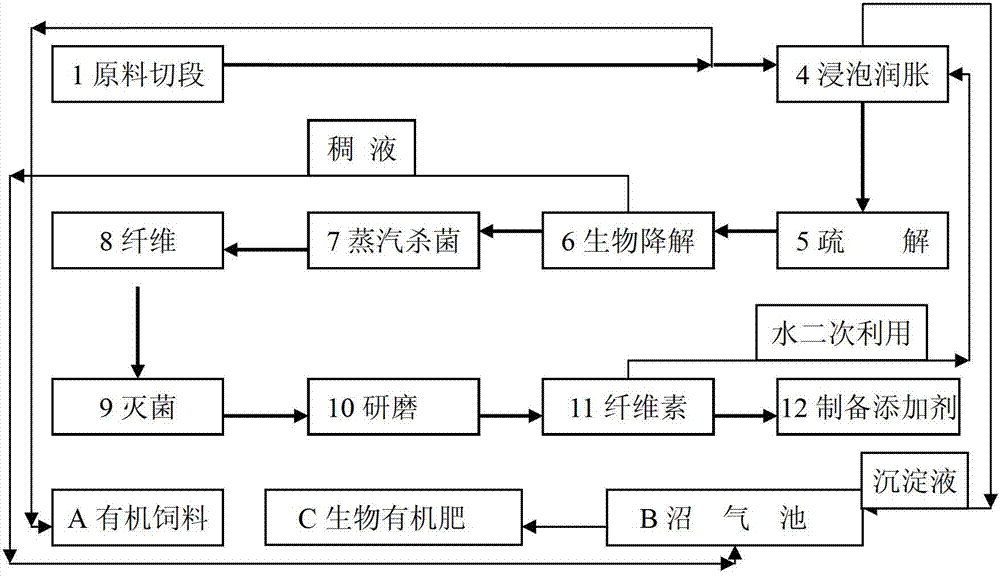Composite flora for biological preparation of cellulose additive, and applications thereof
A technology of cellulose and additives, applied in the field of compound flora for biologically preparing cellulose additives, can solve the problems of chemical preparations cannot be separated from waste liquid, cannot achieve effective recycling and reuse, and organic substances cannot be reused, and saves The effect of coal consumption, low production cost, and improved purity and yield
- Summary
- Abstract
- Description
- Claims
- Application Information
AI Technical Summary
Problems solved by technology
Method used
Image
Examples
Embodiment 1
[0028] The configuration of embodiment 1 bacterial liquid
[0029] The biological bacteria used in the present invention have been preserved on April 6, 2012 at the General Microorganism Center (CGMCC, No. 3, No. 1, Beichen West Road, Chaoyang District, Beijing) of the China Microbiological Culture Collection Management Committee, and the preservation number is CGMCC. Bacillus sp. No.5971, Acinetobacter lwoffii with CGMCC No.5973, Pseudomonas fluorescens with CGMCC No.5974.
[0030] The above-mentioned composite bacteria group is configured into a composite bacteria aqueous solution according to the following mass ratio, which is the bacterial solution:
[0031] Bacillus: Acinetobacter ruckeri: Pseudomonas fluorescens is 2-3:1-2:1-2; the density of the formed bacterial liquid is more than 60 million bacteria / ml, for later use.
Embodiment 2
[0032] Embodiment 2 prepares fiber from woody raw material
[0033] Using caragana as raw material, the cellulose preparation method when woody raw materials are used is described in detail. The other woody raw materials, such as the cellulose preparation method of poplar and willow, can be carried out with reference to this process. When using caragana, the composite flora is configured according to the following mass ratio: Bacillus: Acinetobacter ruckeri: Pseudomonas fluorescens is 3:2:2; when poplar is used, the composite flora is configured according to the following mass ratio Configuration: Bacillus: Acinetobacter ruckeri: Pseudomonas fluorescens is 2:2:2; when willow is used, the composite flora is configured according to the following mass ratio: Bacillus: Acinetobacter ruckeri: Pseudomonas fluorescens Bacteria is 3:1:2.
[0034] For details, please refer to figure 1 , the process flow of the cellulose preparation method is divided into three stages: a preparation ...
Embodiment 3
[0054] Embodiment 3 prepares cellulose from herbal raw material
[0055] Using wheat straw as a raw material, the cellulose preparation method when the herbal raw material is used is explained in detail. The other herbal raw materials, such as the cellulose preparation method of straw and reed, can be carried out with reference to this process.
[0056] When wheat straw is used, the composite flora is configured according to the following mass ratio: Bacillus: Acinetobacter ruckeri: Pseudomonas fluorescens is 3:1:2; when straw is used, the composite flora is configured according to the following mass ratio Configuration: Bacillus: Acinetobacter ruckeri: Pseudomonas fluorescens is 2:2:2; when reed is used, the composite flora is configured according to the following mass ratio: Bacillus: Acinetobacter ruckeri: Pseudomonas fluorescens Bacteria is 3:1:3.
[0057] For details, please refer to figure 2 , the process flow of the cellulose preparation method is divided into three...
PUM
 Login to View More
Login to View More Abstract
Description
Claims
Application Information
 Login to View More
Login to View More - R&D
- Intellectual Property
- Life Sciences
- Materials
- Tech Scout
- Unparalleled Data Quality
- Higher Quality Content
- 60% Fewer Hallucinations
Browse by: Latest US Patents, China's latest patents, Technical Efficacy Thesaurus, Application Domain, Technology Topic, Popular Technical Reports.
© 2025 PatSnap. All rights reserved.Legal|Privacy policy|Modern Slavery Act Transparency Statement|Sitemap|About US| Contact US: help@patsnap.com



